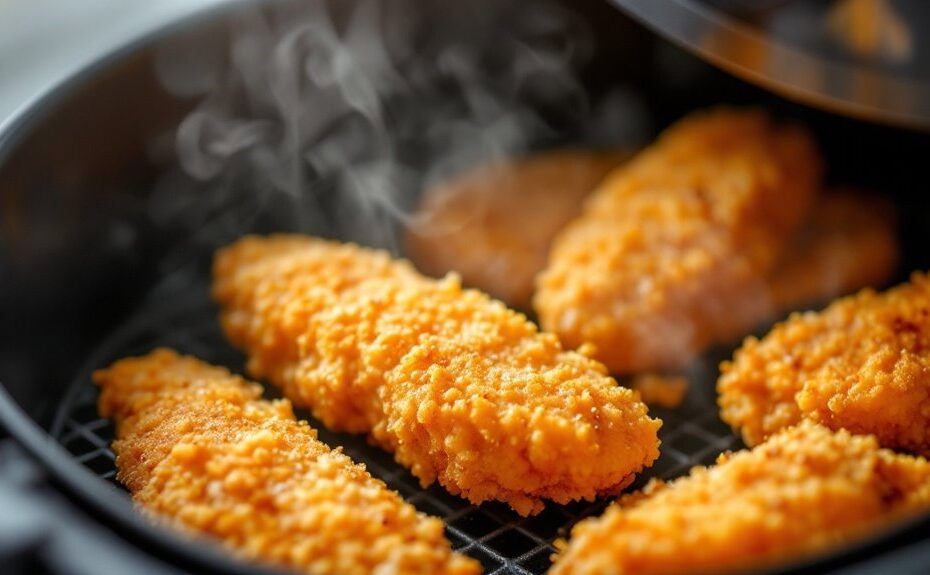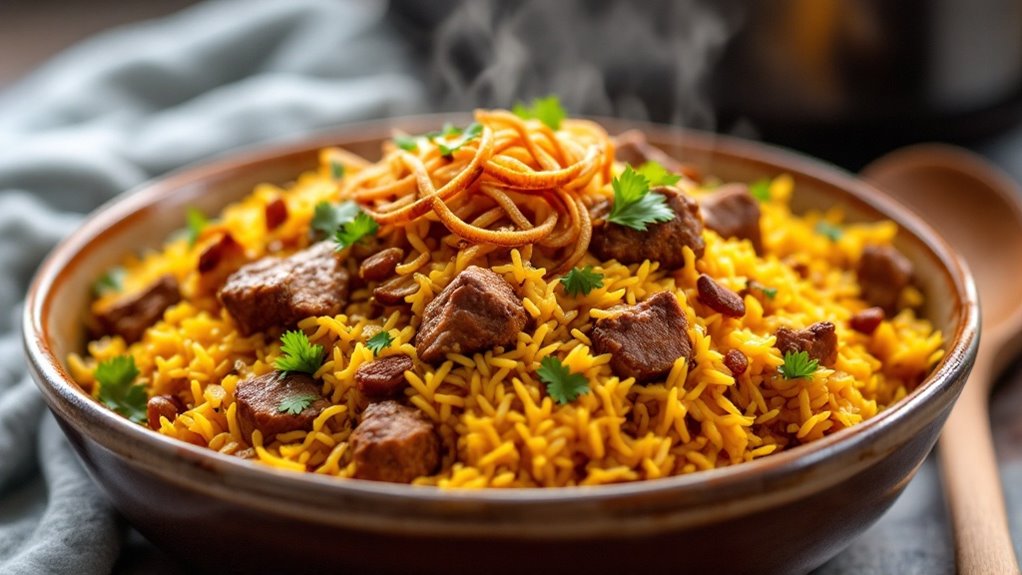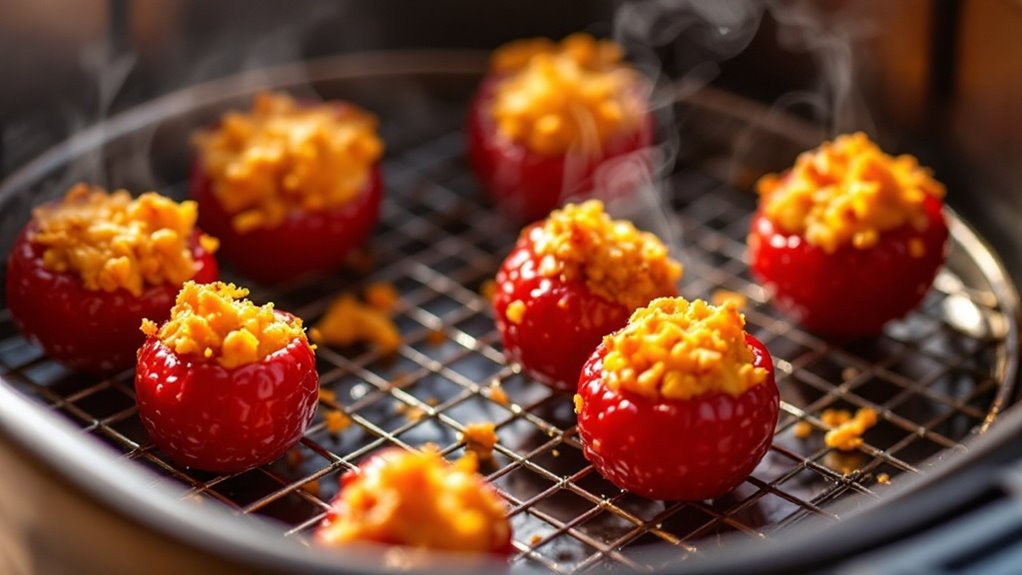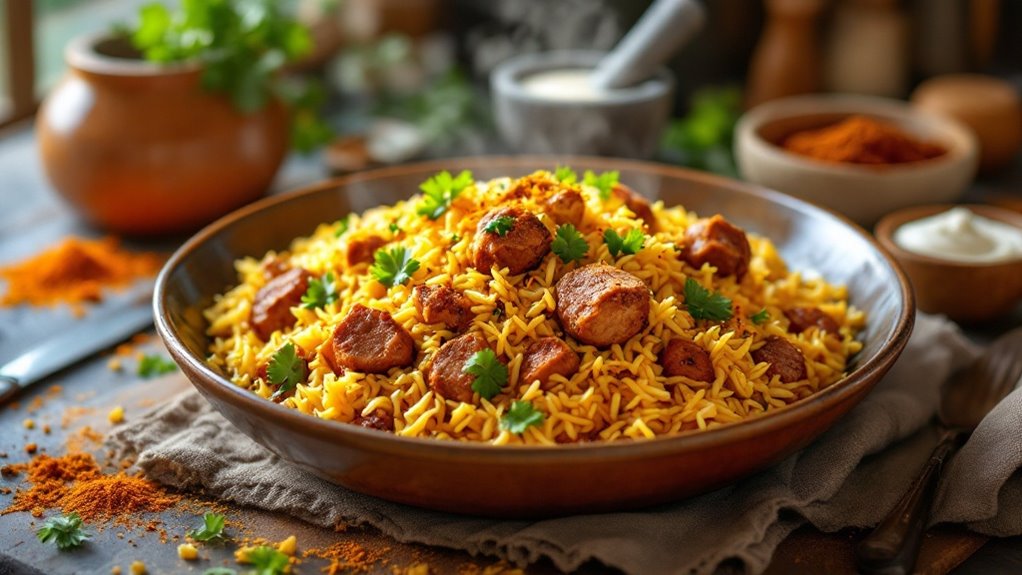You might wonder if you can cook with batter in an air fryer, and the answer is yes—but it's not as straightforward as you'd think. The key lies in choosing the right type of batter and preparing it properly to avoid messy drips or uneven cooking. While air fryers excel at creating crispy textures, achieving that perfect golden coating requires a few adjustments to your usual methods. What if the wrong batter choice ruins your dish, or the cooking time isn't quite right? There's more to uncover about mastering this technique and avoiding common pitfalls.
Key Takeaways
- Yes, you can cook with batter in an air fryer using light, low-moisture batters like tempura or beer batter for crispy results.
- Avoid heavy, dense batters to prevent sogginess; opt for gluten-free or panko-enhanced coatings for better texture.
- Preheat the air fryer to 375°F (190°C) and arrange food in a single layer for even cooking and browning.
- Chill batter for 15–30 minutes and tap off excess to prevent dripping and ensure better adherence during cooking.
- Use a medium-thick batter consistency and lightly spray or brush oil for enhanced browning through the Maillard reaction.
Understanding How Air Fryers Work
Air fryers work by circulating hot air around food at high speeds, creating a crispy exterior similar to deep frying but with substantially less oil. The air fryer mechanics rely on a heating element and a powerful fan, which rapidly distributes heat evenly across the cooking chamber. This convection process guarantees that food cooks quickly and uniformly, while the Maillard reaction—a chemical process between amino acids and reducing sugars—enhances browning and flavor. You'll notice that air fryers operate at temperatures typically ranging from 300°F to 400°F, optimizing the cooking principles for efficiency. By minimizing oil usage, they reduce fat content without sacrificing texture. Understanding these mechanics helps you leverage the appliance's capabilities, securing consistent results for a variety of foods.
Types of Batters Suitable for Air Frying
When using an air fryer, batters that rely on minimal oil and can withstand high heat circulation are ideal for achieving a crispy, golden finish. Light, tempura-style batters made with flour, cornstarch, and carbonated liquids work well, as the bubbles create a porous structure that crisps evenly. Beer batter, with its low viscosity and effervescence, is another excellent choice, as it forms a thin, crunchy coating. For gluten-free options, rice flour or chickpea flour-based batters provide a sturdy base that adheres well to food. Avoid heavy, dense batters, as they may trap moisture and become soggy. Incorporate leavening agents like baking powder to enhance crispiness. Proper batter techniques, such as ensuring a consistent thickness, are essential for even cooking and texture in the air fryer.
Preparing Batter for Air Fryer Cooking
Start by selecting a batter with low moisture content to prevent sogginess in the air fryer. Adjust the batter's viscosity to a medium-thick consistency, ensuring it adheres evenly without dripping excessively. Prepare your ingredients by patting them dry and lightly coating them with flour or starch to enhance batter adhesion and crispiness.
Choosing the Right Batter
To achieve ideal results when cooking with batter in an air fryer, you'll need to select a batter that adheres well to your food and withstands the rapid air circulation. Traditional batter ingredients like flour, eggs, and milk work well, but you can explore batter alternatives such as tempura or beer batter for lighter, crispier textures. Consider using cornstarch or rice flour for gluten-free options, as they create a delicate coating that crisps effectively. Avoid overly thick batters, as they may not cook evenly under the air fryer's intense heat. For proteins, a seasoned flour base can enhance adhesion, while panko breadcrumbs mixed into the batter add extra crunch. Always make sure your batter ingredients are well-mixed to avoid clumps, which can disrupt even cooking.
Proper Batter Consistency
Achieving the proper batter consistency is crucial for successful air fryer cooking, as it guarantees even coating and ideal crispiness. You'll want a batter thickness that's neither too runny nor too thick—aim for a viscosity similar to heavy cream. This guarantees the batter adheres uniformly to your ingredients without dripping or clumping. Use a whisk to combine dry and wet ingredients thoroughly, eliminating lumps that can disrupt adhesion. If the batter is too thin, it won't coat properly; if too thick, it may create uneven textures. Adjust with small increments of liquid or flour to fine-tune the consistency. Proper batter adhesion relies on this balance, as it prevents the coating from peeling off during cooking, guaranteeing a crisp, golden finish in the air fryer.
Prepping Ingredients for Coating
Before you dip your ingredients into the batter, make sure they're prepped to maximize adhesion and texture. Start by patting them dry with paper towels to remove excess moisture, as water can weaken the bond between the batter and the surface. For proteins like chicken or fish, lightly score the surface to create micro-channels that enhance batter penetration. Dusting ingredients with flour or cornstarch before coating guarantees a rough texture, which improves batter thickness adherence. If using vegetables, blanch or par-cook them to reduce water content and prevent sogginess. Confirm your batter thickness is consistent—too thin, and it won't coat evenly; too thick, and it may clump. Proper ingredient preparation secures a crisp, even coating in the air fryer.
Tips for Preventing Batter From Dripping
To prevent batter from dripping in an air fryer, make sure your batter has a thicker consistency by adjusting the liquid-to-dry ingredient ratio. Chill the batter for 15-20 minutes before use to reduce viscosity and improve adhesion to the food surface. Apply the batter evenly and lightly, avoiding excess buildup, to minimize runoff during cooking.
Use Thicker Batter Consistency
When working with batter in an air fryer, a thicker consistency is crucial to prevent dripping and secure even cooking. Batter thickness directly affects air fryer performance, as thinner batters can drip through the basket, causing uneven cooking and potential smoke. A thicker batter adheres better to the food, creating a uniform coating that crisps evenly under the air fryer's rapid convection heat. To achieve this, adjust your batter's liquid-to-dry ingredient ratio, reducing liquids like milk or water slightly. Thicker batters also minimize splattering, which can clog the air fryer's heating elements. Test the batter's consistency by dipping a spoon—it should coat evenly without running off too quickly. This precision secures ideal heat transfer, enhancing texture and preventing messes during cooking.
Chill Batter Before Cooking
Chilling the batter before cooking can markedly improve its adherence and reduce dripping in the air fryer. Proper batter temperature control guarantees the mixture thickens slightly, making it less prone to running off the food. When you chill the batter, the fats solidify, and starches hydrate more effectively, creating a denser, more cohesive texture. Aim for a chilling time of 15–30 minutes, as this allows the batter to stabilize without becoming overly stiff. Longer chilling times can enhance these effects but may require slight adjustments to cooking times. By maintaining a cooler batter, you minimize the risk of uneven coating and secure better heat distribution during air frying. This technique is particularly effective for achieving a crisp, even finish while preventing excess dripping.
Coat Food Evenly and Lightly
While coating food with batter, make sure it's applied evenly and lightly to prevent excess dripping in the air fryer. Ideal batter thickness is critical; aim for a thin, uniform layer that adheres without pooling. Use coating techniques like dipping and gently shaking off excess batter to guarantee consistency. A thicker batter can lead to uneven cooking and dripping, which may cause smoke or uneven browning. For better adhesion, pat the food dry before coating and consider using a dredging step with flour or cornstarch. This creates a surface that binds the batter more effectively. Lightly tapping the coated food on the edge of the bowl removes excess batter, reducing the risk of drips. Precision in application guarantees even cooking and a crisp, golden finish.
Best Foods to Cook With Batter in an Air Fryer
Although air fryers are primarily known for their ability to crisp foods without excess oil, they're also excellent for cooking battered items, provided you use the right techniques. For batter recipes, choose foods with a firm texture, like chicken tenders, fish fillets, or vegetables such as zucchini or cauliflower. These hold up well to air fryer techniques, guaranteeing even cooking and a crispy exterior. Lightly coat the food with a thin layer of batter to prevent sogginess and allow hot air circulation. Preheating the air fryer to 375°F (190°C) secures the batter sets quickly, creating a golden crust. Avoid overcrowding the basket to maintain airflow and prevent uneven results. Experiment with tempura or beer batter for a lighter, crispier finish.
Common Mistakes When Using Batter in an Air Fryer
When cooking with batter in an air fryer, one of the most frequent mistakes is applying too thick a coating, which can trap moisture and prevent proper crisping. Excess batter creates a barrier that hinders heat transfer, leaving the interior soggy. Another issue is batter overflow, where too much batter drips off the food and onto the air fryer basket, causing uneven cooking and potential smoke. Uneven coating is also problematic; if you don't distribute the batter evenly, some areas may overcook while others remain undercooked. To avoid these issues, use a thin, consistent layer of batter and shake off excess before placing the food in the air fryer. This guarantees even heat distribution and ideal texture.
Adjusting Cooking Times and Temperatures
Properly adjusting cooking times and temperatures is key to achieving the best results when using batter in an air fryer. Start by preheating the air fryer to 375°F (190°C), as this temperature guarantees even cooking without burning the batter. Adjusting heat levels may be necessary depending on the thickness of the batter and the food item. For thicker coatings, reduce the temperature by 10-15°F to prevent overcooking the exterior before the interior is done. Monitor cooking progress by checking the food halfway through the recommended time, flipping it if needed to secure uniform browning. Use a food thermometer to verify internal temperatures, aiming for 165°F (74°C) for poultry or 145°F (63°C) for fish. Small adjustments and consistent monitoring prevent undercooking or burning.
How to Achieve a Crispy Coating
To achieve a crispy coating in an air fryer, you'll need to focus on moisture control and heat distribution. Start by making sure your batter thickness is consistent—too thick, and it won't crisp evenly; too thin, and it may not adhere properly. Use coating techniques like double-dipping in flour, batter, and breadcrumbs to create layers that trap less moisture. Preheat the air fryer to guarantee immediate heat transfer, which helps evaporate surface moisture quickly. Arrange food in a single layer, leaving space between items to promote airflow and even crisping. Avoid overcrowding, as it traps steam and softens the coating. Lightly spray or brush oil on the surface to enhance browning through the Maillard reaction. These steps optimize texture by balancing moisture evaporation and heat application.
Cleaning and Maintenance After Cooking With Batter
After cooking with batter in an air fryer, it's vital to clean the appliance promptly to prevent residue buildup, which can affect performance and food quality. Begin by unplugging the air fryer and allowing it to cool. Remove the basket and tray, then soak them in warm, soapy water to loosen any stuck-on batter. Use a non-abrasive sponge or brush for basket cleaning, guaranteeing thorough residue removal without scratching the non-stick coating. Wipe the interior and heating element with a damp cloth to eliminate grease or splatters. Dry all components completely before reassembling to prevent moisture-related damage. Regular maintenance, including checking for oil accumulation in crevices, secures ideal airflow and prevents smoke during future use. Proper cleaning extends the appliance's lifespan and maintains cooking efficiency.
Disclosure: As an Amazon Associate, I earn from qualifying purchases.



